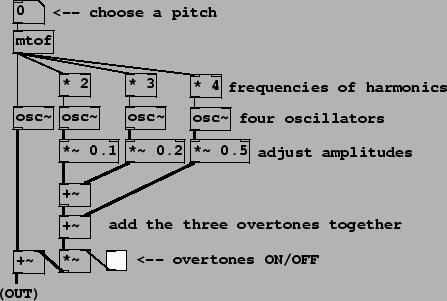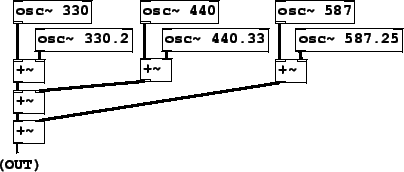




Next: Exercises
Up: Examples
Previous: Conversion between frequency and
Contents
Index
The major triad (Example A06.frequency.pd, Page ![[*]](crossref.png) )
shows one way to combine several sinusoids together by summing.
There are many other possible ways to organize collections of
sinusoids, of which we'll show two. Example A07.fusion.pd (Figure 1.14) shows four oscillators,
whose frequencies are
tuned in the ratio 1:2:3:4, with relative amplitudes 1, 0.1, 0.2, and 0.5. The
amplitudes are set by multiplying the outputs of the oscillators (the
*~ objects below the oscillators).
)
shows one way to combine several sinusoids together by summing.
There are many other possible ways to organize collections of
sinusoids, of which we'll show two. Example A07.fusion.pd (Figure 1.14) shows four oscillators,
whose frequencies are
tuned in the ratio 1:2:3:4, with relative amplitudes 1, 0.1, 0.2, and 0.5. The
amplitudes are set by multiplying the outputs of the oscillators (the
*~ objects below the oscillators).
The second, third, and fourth oscillator are turned on and off using a
toggle switch.
This is a graphical control, like the number box introduced earlier. The
toggle switch puts out 1 and 0 alternately when clicked on with the
mouse. This value is multiplied by the sum of the second, third, and fourth
oscillators, effectively turning them on and off.
Even when all four oscillators are combined (with the toggle switch in the
"1" position), the result fuses into a single tone,
heard at the pitch of the leftmost oscillator. In effect this patch sums a
four-term Fourier series to generate a complex, periodic waveform.
Figure 1.14:
Additive synthesis using harmonically tuned oscillators.
 |
Example A08.beating.pd (Figure 1.15) shows another possibility, in which six
oscillators are tuned into three pairs of neighbors, for instance 330 and 330.2
Hertz. These pairs slip into and out of phase with each other, so that the
amplitude of the sum changes over time. Called
beating,
this phenomenon is frequently used for musical effects.
Figure 1.15:
Additive synthesis: six oscillators arranged into three beating pairs.
 |
Oscillators may be combined in other ways besides simply summing their output,
and a wide range of resulting sounds is available. Example A09.frequency.mod.pd (not
shown here) demonstrates
frequency modulation
synthesis, in which one oscillator
controls another's frequency. This will be more fully described in Chapter
5.





Next: Exercises
Up: Examples
Previous: Conversion between frequency and
Contents
Index
Miller Puckette
2006-12-30
![[*]](crossref.png) )
shows one way to combine several sinusoids together by summing.
There are many other possible ways to organize collections of
sinusoids, of which we'll show two. Example A07.fusion.pd (Figure 1.14) shows four oscillators,
whose frequencies are
tuned in the ratio 1:2:3:4, with relative amplitudes 1, 0.1, 0.2, and 0.5. The
amplitudes are set by multiplying the outputs of the oscillators (the
*~ objects below the oscillators).
)
shows one way to combine several sinusoids together by summing.
There are many other possible ways to organize collections of
sinusoids, of which we'll show two. Example A07.fusion.pd (Figure 1.14) shows four oscillators,
whose frequencies are
tuned in the ratio 1:2:3:4, with relative amplitudes 1, 0.1, 0.2, and 0.5. The
amplitudes are set by multiplying the outputs of the oscillators (the
*~ objects below the oscillators).

